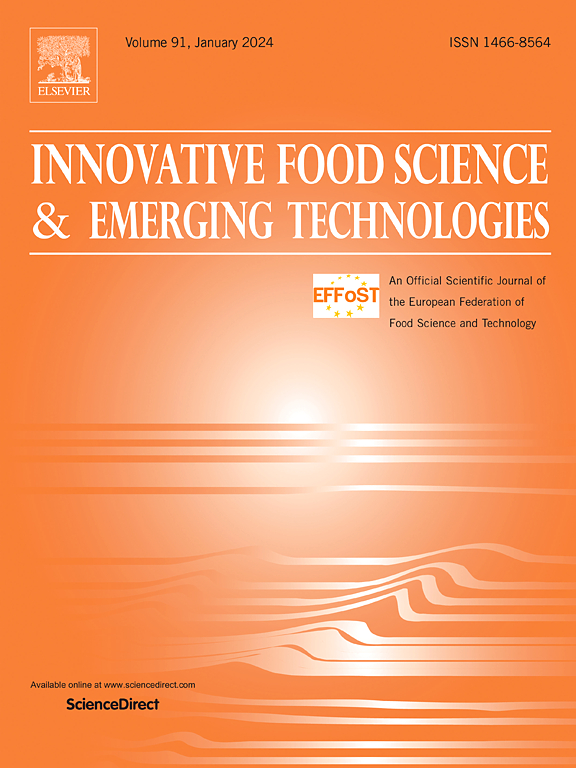活塞间隙和微流控高压一体化均质系统对柠檬乳液稳定性和质量的影响
IF 6.3
1区 农林科学
Q1 FOOD SCIENCE & TECHNOLOGY
Innovative Food Science & Emerging Technologies
Pub Date : 2025-07-11
DOI:10.1016/j.ifset.2025.104114
引用次数: 0
摘要
柠檬乳剂富含维生素C、有机酸和膳食纤维,因其清爽的风味和相关的健康益处而被广泛应用于食品中。然而,通常用于延长保质期的传统巴氏灭菌(PT)技术往往会导致营养降解和感官退化。研究了活塞间隙和微流控技术(IPM-HS)相结合的高压均质系统对柠檬乳液质量和稳定性的影响。由新鲜柠檬汁、橄榄油和Tween 80组成的乳剂分别在200、300和400 MPa下处理。IPM-HS处理显著提高了浊度(高达1.5倍),减小了500 nm以下的粒径,并实现了有效的微生物减少,在任何压力水平下都没有检测到活菌。此外,EAI和ESI值随着压力的增加而显著增加,表明乳化能力和长期物理稳定性增强。经IPM-HS处理后,Zeta电位的负值增加,表明静电斥力增强,乳液稳定性增强。在400 MPa下,L*值由62.39增加到89.81,颜色由淡黄色转变为乳白色。与未经处理和热处理的对照相比,经IPM-HS处理的乳剂在30天的储存过程中表现出稳定的纳米结构,没有相分离。总酚含量由0.49 mg GAE/g增加到0.58 mg GAE/g (p <;0.05),抗氧化活性保持良好。使用电子舌头和电子鼻子进行的味道分析显示,与对照组的偏差最小。总的来说,IPM-HS在保持感官属性的同时显著提高了乳液的稳定性、理化质量和营养保留,强调了其作为一种有前途的乳基产品开发的非热加工技术的潜力。本文章由计算机程序翻译,如有差异,请以英文原文为准。
Impact of an integrated piston-gap and microfluidic high-pressure homogenization system on the stability and quality of lemon emulsions
Lemon emulsion, enriched with vitamin C, organic acids, and dietary fiber, is widely utilized in food applications due to its refreshing flavor and associated health benefits. However, traditional pasteurization (PT) techniques commonly employed to prolong shelf life often lead to nutrient degradation and sensory deterioration. This study investigates the impact of a high-pressure homogenization system integrating piston-gap and microfluidic technologies (IPM-HS) on the quality and stability of lemon emulsions. Emulsions composed of fresh lemon juice, olive oil, and Tween 80 were treated at 200, 300, and 400 MPa. The IPM-HS treatment significantly enhanced turbidity (up to 1.5-fold), reduced particle size below 500 nm, and achieved effective microbial reduction, with no viable microorganisms detected at any pressure level. In addition, EAI and ESI values increased significantly with pressure, indicating enhanced emulsifying capacity and long-term physical stability. Zeta potential measurements showed more negative values after IPM-HS treatment, suggesting improved electrostatic repulsion and greater emulsion stability. The L* value increased markedly from 62.39 to 89.81 at 400 MPa, indicating a shift in color from light yellow to milky white. Emulsions treated with IPM-HS exhibited stable nanostructures with no phase separation during 30-day storage, in contrast to untreated and thermally treated controls. Moreover, total phenolic content increased from 0.49 to 0.58 mg GAE/g (p < 0.05), and antioxidant activity was well preserved. Flavor analysis using electronic tongue and nose revealed minimal deviation from the control group.
Overall, IPM-HS markedly improves emulsion stability, physicochemical quality, and nutritional retention while maintaining sensory attributes, underscoring its potential as a promising non-thermal processing technology for emulsion-based product development.
求助全文
通过发布文献求助,成功后即可免费获取论文全文。
去求助
来源期刊
CiteScore
12.00
自引率
6.10%
发文量
259
审稿时长
25 days
期刊介绍:
Innovative Food Science and Emerging Technologies (IFSET) aims to provide the highest quality original contributions and few, mainly upon invitation, reviews on and highly innovative developments in food science and emerging food process technologies. The significance of the results either for the science community or for industrial R&D groups must be specified. Papers submitted must be of highest scientific quality and only those advancing current scientific knowledge and understanding or with technical relevance will be considered.

 求助内容:
求助内容: 应助结果提醒方式:
应助结果提醒方式:


